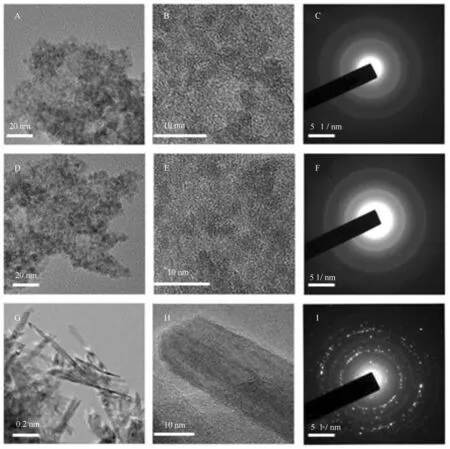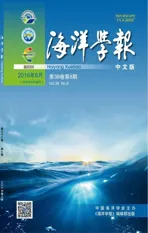深海嗜热异化铁还原菌Caloranaerobacter ferrireducens DY22619T对不同铁氧化物的铁还原特性
2016-08-08李曦曾湘张昭邵宗泽
李曦,曾湘,张昭,邵宗泽*
(1. 国家海洋局第三海洋研究所 国家海洋局海洋生物遗传资源重点实验室,福建 厦门 361005;2.厦门市海洋生物遗传资源重点实验室(省部共建重点实培育基地),福建 厦门 361005;3.福建省海洋生物遗传资源重点实验室,福建 厦门 361005;4.福建省海洋生物资源开发利用协同创新中心,福建 厦门 361005)
深海嗜热异化铁还原菌Caloranaerobacter ferrireducens DY22619T对不同铁氧化物的铁还原特性
李曦1,2,3,4,曾湘1,2,3,4,张昭1,2,3,4,邵宗泽1,2,3,4*
(1. 国家海洋局第三海洋研究所 国家海洋局海洋生物遗传资源重点实验室,福建 厦门 361005;2.厦门市海洋生物遗传资源重点实验室(省部共建重点实培育基地),福建 厦门 361005;3.福建省海洋生物遗传资源重点实验室,福建 厦门 361005;4.福建省海洋生物资源开发利用协同创新中心,福建 厦门 361005)
摘要:异化铁还原微生物在铁元素的地球化学循环中具有重要意义。深海热液活动是大洋铁元素的重要来源,目前深海热液环境中铁代谢相关微生物研究很少。本文对一株分离自深海热液区的嗜热异化铁还原菌新种Caloranaerobacter ferrireducens DY22619T的铁还原特性进行分析,比较了该菌对无定形羟基氧化铁、无定形铁氧化物和针铁矿3种不同铁氧化物的铁还原速率;并利用透射电镜对矿化产物进行矿物形貌、组成元素和晶型的分析。研究发现该菌生长在指数期至稳定期时,铁还原速率最快,其中对无定形羟基氧化铁和无定形铁氧化物的还原速率较高,达2.82 μmol/h和2.15 μmol/h;透射电镜结果表明,该菌可将3种不同胞外铁氧化物均还原矿化形成颗粒状磁铁矿,由针铁矿矿化形成的磁铁矿少但粒径最大,而由无定形铁氧化物形成的磁铁矿晶面不同于另外两种铁氧化物。结果表明,该菌有很强的铁还原和矿化能力,能厌氧呼吸还原三价铁氧化物,但是铁氧化物的性质对该菌胞外铁还原能力和矿化形成的磁铁矿的性质有重要影响。本研究为认识深海热液环境中异化铁还原菌在铁元素的地球化学循环和生物成矿过程提供了参考。
关键词:Caloranaerobacter ferrireducens;Fe(Ⅲ)还原;磁铁矿;生物成矿
1引言
异化铁还原是指微生物利用细胞外Fe(Ⅲ)为末端电子的受体,通过氧化作为电子供体的有机物将Fe(Ⅲ)还原为Fe(Ⅱ)。能通过上述代谢形式进行生命活动的微生物即为异化铁还原菌,它们广泛分布于厌氧环境中,在含铁矿物中铁的还原和矿物的迁移转化以及铁元素的地球化学循环具有重要意义[1—2]。
目前分离得到的异化铁还原微生物主要来自于常温环境下的淡水沉积物,研究最为深入的是异化铁还原菌地杆菌属和希瓦氏菌属,特别是在铁还原的电子传递机制以及铁还原菌与矿物相互作用等方面展开了大量研究。如李陛等[3]研究发现培养温度的升高以及蒽醌-2,6-二磺酸盐(AQDS)均有利于ShewanellaputrefaciensCN32铁还原快速形成磁铁矿;欧阳冰洁等[4]研究发现ShewanellaoneidensisMR-1能异化还原针铁矿,同时形成磁铁矿、绿锈等次生矿物。但是对深海热液环境中异化铁还原微生物研究很少。
铁在大部分海洋中的浓度很低(通常小于1 nmol/L),深海热液区是重要的铁储库,当热液流进入底部海水的时候会形成大量的富含铁的硫化物和羟基氧化铁[5],这为异化铁还原微生物的生长提供了大量的电子受体。由于热液区样品的难以获取,目前深海热液区只有少量异化铁还原菌Marinitogacamini、Deferribacterabyssi、Deferribacterautotrophicus等被分离鉴定[6—8],Lin等[9]报道了两株分离自深海热液区的超嗜热古菌Hyperthermushephaesti和Pyrodictiumdelaneyi可以还原无定形铁氧化物形成磁铁矿,但是有关细菌对不同铁氧化矿物的铁还原能力的研究尚未见报道。
CaloranaerobacterferrireducensDY22619T是本实验室从东太平洋深海热液区的硫化物样品中分离纯化得到的一株细菌新种,其最适生长温度60~65℃,严格厌氧,能以不可溶的三价铁作为胞外电子受体[10]。本文选用了两种无定形的铁氧化物和结晶程度高的针铁矿作为胞外的电子受体,研究了嗜热异化铁还原菌DY22619T对3种不同结晶性的铁氧化物铁还原速率和矿化产物的分析,研究结果将有助于认识深海热液区中异化铁还原菌在铁元素的地球化学循环的作用和生物成矿的过程。
2材料和方法
2.1材料
2.1.1菌株
CaloranaerobacterferrireducensDY22619T,分离纯化自东太平洋洋中脊热液区采集的硫化物样品22VI-EPR-S025-TVG19,保存于中国海洋微生物菌种保藏管理中心MCCC(编号为1A06455)。
2.1.2培养基
人工海水:23 g/L NaCl, 5.0 g/L MgCl2·6H2O, 0.15 g/L CaCl2, 0.7 g/L KCl, 0.4 g/L (NH4)2SO4, 0.05 g/L NaBr, 0.01 g/L SrCl2·6H2O。
(1)海洋发酵型铁还原菌培养基(MFFRE),1 L 人工海水中加入10 g/L细菌学蛋白胨, 50 mmol/L 无定形羟基氧化铁, 6.05 g/L PIPES,0.001 g/L刃天青;灭菌后再用注射器添加 0.5 g/L半胱氨酸。
(2)YTPS培养基,用于菌种的活化,1 L人工海水中加入5 g/L酵母抽提物,5 g/L胰蛋白胨,3 g/L丙酮酸钠, 6.05 g/LPIPES , 0.5 g/L半胱氨酸和0.001 g/L刃天青。将10 mL培养基分装到厌氧管中,充以纯氮气5 min,然后快速地加上橡胶塞和铝盖。
灭菌前,调节培养基的pH到7.3,灭菌后pH降为7.0。灭菌条件为121℃,20 min。
2.1.33种不同铁氧化物的制备
无定形羟基氧化铁(Amorphous FeOOH):0.4 mol/L FeCl3溶液用10 mol/L NaOH调节pH至7.0,然后8 000 r/min离心2 min,去上清,重悬于去离子水中,反复清洗3~4次,直至上清液中的氯离子浓度小于1.0 mmol/L。
无定形铁氧化物(Amorphous Fe(Ⅲ) Oxide):溶解109 g FeCl3的于500 mL超纯水中,用10 mol/L NaOH滴定至pH为9.0,超纯水清洗沉淀,直至上清液中氯离子浓度小于1.0 mmol/L。
针铁矿(Goethite):将0.4 mol/L FeCl3溶液用10 mol/L NaOH调节pH至12.0,室温放置7 d,然后90℃放置16 h,超纯水清洗沉淀,直至上清液中氯离子浓度小于1.0 mmol/L[11]。
2.2实验方法
2.2.1细菌厌氧培养
在装有海洋发酵型铁还原菌培养基厌氧管中,分别用50 mmol/L 无定形羟基氧化铁、无定形铁氧化物和针铁矿作为胞外的电子受体,置于60℃ 培养箱进行静止培养,对不同培养时间节点的培养液进行取样,测定细胞数目和二价铁产物的总含量。设不接种的对照组,每种处理3个重复。
2.2.2细菌计数
用注射器吸取厌氧管中的菌液,滴加到血球计数板上,在油镜下观察,计算细胞个数。
2.2.3Fe(Ⅱ)的测定
根据Ferrozine方法[12]:将0.1 mL的样品溶液加入于5 mL的0.5 mol/L盐酸中,震荡混匀,再从中吸取0.1 mL加入到5 mL的菲啰嗪溶液中,漩涡震荡15 s,室温静置30 min以待显色反应完全,吸取0.2 mL用酶标仪测量OD562,该方法测得的是体系中的二价铁的总量。
2.2.4固相样品的分析方法
从厌氧管中收集少量黑色的固相样品,于厌氧手套箱中清洗,离心沉淀,用去离子水重悬,再用毛细吸管吸取少量固体悬液滴在铜网上,经3~5 min后,用滤纸吸去多余的水,待样品干燥后,最后使用透射电子显微镜JEM-2100(日本电子株式会社)对矿化产物的形貌和性质进行分析。
3结果
3.1DY22619T对3种铁氧化物还原速率的比较和分析
以无定形羟基氧化铁、无定形铁氧化物和针铁矿3种不可溶的铁氧化物作为胞外电子受体,该菌能够进行Fe(Ⅲ)还原,将不可溶的三价铁还原成二价铁,并在细胞外形成大量的黑色沉淀。
当以无定形羟基氧化铁和无定形铁氧化物分别作为胞外的电子受体时,结果发现36 h细胞生长到达稳定期,其细胞数分别达到了2.11×108个/mL、1.92×108个/mL,48 h后细胞生长进入衰退期,细胞数目减少,培养至144 h时,还原生成的总Fe(Ⅱ)浓度分别高达14.01mmol/L、12.32 mmol/L(图 1A,1B)。24 h至48 h(即指数期到稳定期)其铁还原速率最快分别为2.82 μmol /h、2.15 μmol /h(图 2)。

图1 DY22619T以3种不同铁氧化物作为胞外的电子受体,菌体生长曲线和总Fe(Ⅱ)浓度的变化Fig.1 Variation of cell concentration coupled with the total Fe(Ⅱ) concentration increase by DY22619T using different three iron oxides as an extracellular electron acceptora.为无定形羟基氧化铁;b.为无定形铁氧化物;c.为针铁矿。●代表细胞数目;○代表总二价铁离子浓度a:Amorphous FeOOH;b:Amorphous Fe(Ⅲ) Oxide;c:Goethite. ●:cell count;○:total Fe(Ⅱ) concentration
当以针铁矿作为胞外电子受体时,细胞生长较慢,48 h到达稳定期,细胞数仅达到3.57×107个/mL,细菌生长速率远低于前两组,培养至72 h时,细胞大量死亡,最后细菌还原针铁矿生成的总Fe(Ⅱ)浓度达到4.51 mmol/L(图1c)。铁还原速率最快为0.98 μmol/h(图2)。

图2 DY22619T以3种不同铁氧化物作为胞外的电子受体的Fe(Ⅲ)还原速率的比较Fig.2 A comparison of Fe(Ⅲ) reduction rate by DY22619T using three different iron oxides as an extracellular electron acceptor●代表无定形羟基氧化铁;■代表无定形铁氧化物;▲代表针铁矿●:Amorphous FeOOH;■:Amorphous Fe(Ⅲ) Oxide:▲:Goethite

图3 3种铁氧化物矿物透射电镜观察Fig.3 TEM photographs of three different iron oxidesA,B,C为无定形羟基氧化铁;D,E,F为无定形铁氧化物;G,H,I:代表针铁矿。A,D,G为透射电镜图;B,E,H为高分辨透射电镜图;C,F,I为矿物选区电子衍射A,B,C:Amorphous FeOOH;D,E,F:Amorphous Fe(Ⅲ) Oxide;G,H,I:Goethite. A,D,G:observation under TEM;B,E,H:observation under HR-TEM;C,F,I:SAED of the minerals

图4 DY22619T还原无定形羟基氧化铁矿化产物磁铁矿的矿物分析Fig.4 Mineral analysis of the magnetite bioproducts formed by DY22619T reducing Amorphous FeOOHA和D为透射电镜图;B为高分辨透射电镜图;C为矿物元素分析;E为矿物选区电子衍射A and D:TEM of minerals;B:HR-TEM of minerals;C:EDS of minerals;E:SAED of minerals

图5 DY22619T还原无定形铁氧化物矿化产物磁铁矿的矿物分析Fig.5 Mineral analysis of the magnetite bioproducts formed by DY22619T reducing Amorphous Fe(Ⅲ) OxideA和D为透射电镜图;B为高分辨透射电镜图;C为矿物元素分析;E为矿物选区电子衍射A and D:TEM of minerals;B:HR-TEM of minerals;C:EDS of minerals;E:SAED of minerals

图6 DY22619T还原针铁矿矿化产物磁铁矿的矿物分析Fig.6 Mineral analysis of the magnetite bioproducts formed by DY22619T reducing goethiteA和D为透射电镜图;B为高分辨透射电镜图;C为矿物元素分析;E为矿物选区电子衍射A and D:TEM of minerals;B:HR-TEM of minerals;C:EDS of minerals;E:SAED of minerals
3.23种铁氧化物矿化产物的分析
本实验制备了无定形羟基氧化铁、无定形铁氧化物、针铁矿3种铁氧化矿物。其中,无定形羟基氧化铁(图3A,3B,3C)和无定形铁氧化物(图3D,3E,3F)在电镜下呈颗粒状,是无定形的铁矿物,没有明显的晶格,前者的颗粒粒径略小于后者。而人工合成的针铁矿(图3G,3H,3I)在电镜下为针形或板状聚集物,结晶性很好,有明显的晶格,为强晶型的铁矿物。
DY22619T以无定形羟基氧化铁作为胞外电子受体时,电镜结果显示菌体将细胞外的不可溶的Fe(Ⅲ)进行还原和矿化形成大量的结晶良好的纳米级SP磁铁矿颗粒(图4A),颗粒平均粒径约为4.00 nm(50个平均大小)(图4D);能谱分析表明矿化产物的成分主要为铁元素和氧元素(图4C);高分辨透射电镜和选区电子衍射显示了磁铁矿的主要晶面(440)、(511)、(422)、(220)、(311)、(400)(图4B,4E)。
DY22619T以无定形铁氧化物作为细胞外的电子受体时,电镜结果显示菌体将细胞外的不可溶的Fe(Ⅲ)进行还原和矿化形成大量的磁铁矿颗粒(图5A),颗粒平均粒径约为7.50 nm(50个平均大小)(图5D);能谱分析表明矿化产物的成分主要为铁元素和氧元素(图5C);高分辨透射显微镜和选区电子衍射显示了磁铁矿的主要晶面(511)、(422)、(003)、(220)、(311)、(400)、(111)(图5B,5E)。
以针铁矿作为细胞外电子受体时,电镜结果显示尽管针铁矿结晶非常好,但是DY22619T也能将针铁矿部分还原和矿化形成少量的磁铁矿颗粒(图 6A),颗粒结晶度高,其平均的粒径大小较大能达到约15.00 nm(50个平均大小)(图6D),这远远大于还原无定形铁氧化物所形成的磁铁矿颗粒。能谱分析表明,所生成矿物的元素主要为铁和氧(图6C);高分辨透射电镜和选区电子衍射显示了磁铁矿的主要晶面(440)、(511)、(422)、(220)、(311)、(400) (图6B,6E)。
综上所述,菌株DY22619T可将细胞内厌氧氧化有机物所产生的电子传递到细胞外,将胞外含铁矿物中的Fe(Ⅲ)还原成Fe(Ⅱ),并形成新的结晶性良好的磁铁矿颗粒,其中还原针铁矿形成的磁铁矿颗粒最大,而还原无定形羟基氧化铁形成的颗粒最小。3组实验中由于胞外电子受体不一样,细菌异化铁还原形成的磁铁矿晶面的生长也不完全一致,其中细菌还原无定形铁氧化物矿化形成的磁铁矿有不同于另外两个实验组晶面(003)、(111)的生长。
4讨论
前人研究表明,当细胞外存在Fe(Ⅲ)作为电子受体比单纯进行发酵代谢能产出更多的能量,对细菌的生长有一定的促进作用[13—15]。3组铁还原速率实验结果表明,当无定形羟基氧化铁和无定形铁氧化物作为胞外电子受体时,DY22619T生长数量较高,铁还原速率较大。无定形羟基氧化铁和无定形铁氧化物为细小颗粒状,结晶程度差,因此具有更大的比表面积和高表面活性,有利于细菌对矿物还原矿化,大多数均被细菌还原并矿化成了纳米级的磁铁矿颗粒;而针铁矿是一种结晶程度相当好的铁氧化物,在电镜下呈现完好的针状板片状晶体(图6A),难以被细菌利用,因此矿化形成的磁铁矿颗粒较少,培养中仍有大量未被利用的针铁矿(图5A)。
在高铁环境的微生物还原过程中,微生物与矿物直接接触的情况下,细胞可以通过胞外导电附属物(如纳米导管)[16—18]或胞外电子穿梭体(如AQDS、核黄素)[19—23]直接和铁氧化物进行电子传递[24],另外,细菌分泌的有机分子也会通过表面络合作用促进铁氧化物的溶解[25—26],释放出的Fe(Ⅲ)离子更易于被微生物还原。本研究通过透射电镜观察细胞时未观察到胞外导电附属物,该菌可能没有纳米导管进行电子传递。将铁矿物置于透析袋里(阻隔分子量12 000),细胞仍然可以还原透析袋里的三价铁氧化物,说明该菌不通过直接接触就可以进行铁还原[27]。我们推测该菌可自身分泌的具有氧化还原活性的小分子作为电子穿梭体进行电子传递,生成Fe(Ⅲ)和Fe(Ⅱ)离子;另一方面,由于研究体系里有大量的溶解态有机物,因此铁矿物本身可能在有机配体的络合作用下发生溶解,溶解态的Fe(Ⅲ)被细菌还原成Fe(Ⅱ),溶液中Fe(Ⅲ)和Fe(Ⅱ)会与阴离子结合并进一步矿化形成稳定的Fe(Ⅱ)-Fe(Ⅲ)混合价态矿物磁铁矿。
Sales等[28]系统的研究了几株典型的分离自淡水沉积物的铁还原菌的铁还原速率,其中ShewanallaputrefaciensW-3-18-1的最大铁还原速率为17.67×10-2μmol/h,而目前报道的分离自热液区的Shewanallasp. strain PV-4,其铁还原速率高达3.12 μmol/h[29—30],本文研究的DY22619T分离自深海热液区,其最大铁还原速率也高达2.88 μmol/h,由此看出海洋来源的尤其是深海热液区的铁还原菌其铁还原速率远远高于淡水沉积物中的铁还原菌,这可能与深海热液区中富铁的环境有关[5],大量的铁氧化物和含铁矿物给铁还原菌的生长提供了电子受体。在深海环境中主要有3类铁还原菌中温型、嗜热型和超嗜热型[31],其中超嗜热铁还原菌是一些具有铁还原能力的古菌,主要包括地球状菌属Geoglobus[32]、超热菌属Hyperthermus[33—34]、高温球菌属Thermococcus[35]等;嗜热铁还原菌报道较少,仅有广古菌门的产甲烷球菌属Methanococcus[36]和脱铁杆菌属Deferribacter[7—8];而中温铁还原菌主要有希瓦式菌属Shewanalla[37]、脱硫弧菌属Desulfovibrio[38]、脱硫叶菌属Desulfobulbus[39]脱硫单胞菌属Desulfuromonas[40—41]等。本文C.ferrireducensDY22619T代表了一类嗜热型的铁还原菌,它可能与其他铁还原菌共同参与深海热液环境中铁元素的地球化学循环以及含铁矿物的迁移和转化。而深海热液区是一个高温高压的环境,DY22619T可在0.1~30 MPa静水压力下生长,下一步我们将开展高压下该菌铁还原能力与矿化产物结构的分析,深入理解原位环境下异化铁还原菌在铁元素地球化学循环的作用。
5结论
CaloranaerobacterferrireducensDY22619T的确具有异化铁还原和矿化能力,能以结晶性不同的无定形羟基氧化铁、无定形铁氧化物与针铁矿3种铁氧化物作为胞外电子受体,将含铁矿物中的Fe(Ⅲ)还原成Fe(Ⅱ),并形成新的结晶性良好的磁铁矿颗粒。其中对无定形的铁矿物还原形成的Fe(Ⅱ)浓度高达14 mmol/L,对强晶型的针铁矿也能部分还原矿化。尽管该菌能将三价铁矿物还原矿化形成纳米级的磁铁矿颗粒,但是铁矿物的结晶性对其铁还原速率、矿化形成的磁铁矿的大小以及晶面生长有着重要影响。
参考文献:
[1]Myers C R, Nealson K H. Bacterial manganese reduction and growth with manganese oxide as the sole electron acceptor[J]. Science, 1988, 240(4857): 1319-1321.
[2]Lovley D R. Dissimilatory Fe(Ⅲ) and Mn(Ⅳ) reduction[J]. Microbiology and Molecular Biology Reviews, 1991, 55(2): 259-287.
[3]李陛, 吴文芳, 李金华, 等. 温度和电子传递体AQDS对铁还原细菌ShewanellaputrefaciensCN32矿化产物的影响[J]. 地球物理学报, 2011, 54(10): 2631-2638.
Li Bi, Wu Wenfang, Li Jinhua, et al. Effects of temperature on biomineralization of iron reducing bacteriaShewanellaputrefaciensCN32[J]. Chinese Journal of Geophysics, 2011, 54(10): 2631-2638.
[4]欧阳冰洁, 陆现彩, 刘欢, 等. 希瓦氏奥奈达菌MR-1还原针铁矿的实验研究及地球化学意义[J]. 矿物学报, 2013, 33(3): 389-396.
Ouyang Bingjie, Lu Xiancai, Liu Huan, et al. Reduction of goethite byShewanellaoneidensisMR-1 and its geochemical implication[J]. Acta Mineralogica Sinica, 2013, 33(3): 389-396.
[5]Hekinian R, Hoffert M, Larque P, et al. Hydrothermal Fe and Si oxyhydroxide deposits from south Pacific intraplate volcanoes and East Pacific rise axial and off-axial regions[J]. Economic Geology, 1993, 88(8): 2099-2121.
[6]Slobodkina G B, Kolganova T V, Chernyh N A, et al.Deferribacterautotrophicussp. nov., an iron(Ⅲ)-reducing bacterium from a deep-sea hydrothermal vent[J]. International Journal of Systematic and Evolutionary Microbiology, 2009, 59(6): 1508-1512.
[7]Miroshnichenko M L, Slobodkin A I, Kostrikina N A, et al.Deferribacterabyssisp. nov., an anaerobic thermophile from deep-sea hydrothermal vents of the Mid-Atlantic Ridge[J]. International Journal of Systematic and Evolutionary Microbiology, 2003, 53(5): 1637-1641.
[8]Wery N, Lesongeur F, Pignet P, et al.Marinitogacaminigen. nov., sp. nov., a rod-shaped bacterium belonging to the order Thermotogales, isolated from a deep-sea hydrothermal vent[J]. International Journal of Systematic and Evolutionary Microbiology, 2001, 51(2): 495-504.
[9]Lin T J, Breves E A, Dyar M D, et al. Magnetite formation from ferrihydrite by hyperthermophilic archaea from Endeavour Segment, Juan de Fuca Ridge hydrothermal vent chimneys[J]. Geobiology, 2014, 12(3): 200-211.
[10]Zeng Xiang, Zhang Zhao, Li Xi, et al.Caloranaerobacterferrireducenssp. nov., an anaerobic, thermophilic, iron (Ⅲ)-reducing bacterium isolated from deep-sea hydrothermal sulfide deposits[J]. International Journal of Systematic and Evolutionary Microbiology, 2015, 65(6): 1714-1718.
[11]Lovley D R, Philips E J P. Novel mode of microbial energy metabolism: organic carbon oxidation coupled to dissimilatory reduction of iron or manganese[J]. Applied and Environmental Microbiology, 1988, 54(6): 1472-1480.
[12]Stookey L L. Ferrozine-a new spectrophotometric reagent for iron[J]. Analytical Chemistry, 1970, 42(7): 779-781.
[13]Lovley D R, Holmes D E, Nevin K P. Dissimilatory Fe(Ⅲ) and Mn(Ⅳ) reduction[J]. Advances in Microbial Physiology, 2004, 49: 219-286.
[14]Lehours A C, Rabiet M, Morel-Desrosiers N, et al. Ferric iron reduction by fermentative strain BS2 isolated from an iron-rich anoxic environment (Lake Pavin, France)[J]. Geomicrobiology Journal, 2010, 27(8): 714-722.
[15]Vecchia E D, Suvorova E I, Maillard J, et al. Fe(Ⅲ) reduction during pyruvate fermentation byDesulfotomaculumreducensstrain MI-1[J]. Geobiology, 2014, 12(1): 48-61. [16]Childers S E, Ciufo S, Lovley D R.Geobactermetallireducensaccesses insoluble Fe(Ⅲ) oxide by chemotaxis[J]. Nature, 2002, 416(6882): 767-769.
[17]Gorby Y A, Yanina S, McLean J S, et al. Electrically conductive bacterial nanowires produced byShewanellaoneidensisstrain MR-1 and other microorganisms[J]. Proceedings of the National Academy of Sciences of the United States of America, 2006, 103(30): 11358-11363.
[18]Reguera G, McCarthy K D, Mehta T, et al. Extracellular electron transfer via microbial nanowires[J]. Nature, 2005, 435(7045): 1098-1101.
[19]Lovley D R, Coates J D, Blunt-Harris E L, et al. Humic substances as electron acceptors for microbial respiration[J]. Nature, 1996, 382(6590): 445-448.
[20]Nevin K P, Lovley D R. Mechanisms for accessing insoluble Fe(Ⅲ) oxide during dissimilatory Fe(Ⅲ) reduction byGeothrixfermentans[J]. Applied and Environmental Microbiology, 2002, 68(5): 2294-2299. [21]Nevin K P, Lovley D R. Mechanisms for Fe(Ⅲ) oxide reduction in sedimentary environments[J]. Geomicrobiology Journal, 2002, 19(2): 141-159.
[22]Newman D K, Kolter R. A role for excreted quinones in extracellular electron transfer[J]. Nature, 2000, 405(6782): 94-97.
[23]Turick C E, Tisa L S, Caccavo Jr F. Melanin production and use as a soluble electron shuttle for Fe(Ⅲ) oxide reduction and as a terminal electron acceptor byShewanellaalgaeBrY[J]. Applied and Environmental Microbiology, 2002, 68(5): 2436-2444.
[24]Weber K A, Achenbach L A, Coates J D. Microorganisms pumping iron: anaerobic microbial iron oxidation and reduction[J]. Nature Reviews Microbiology, 2006, 4(10): 752-764.
[25]Hernandez M E, Kappler A, Newman D K. Phenazines and other redox-active antibiotics promote microbial mineral reduction[J]. Applied and Environmental Microbiology, 2004, 70(2): 921-928.
[26]Nevin K P, Lovley D R. Potential for nonenzymatic reduction of Fe(Ⅱ) via electron shuttling in subsurface sediments[J]. Environmental Science & Technology, 2000, 34(12): 2472-2478.
[27]张昭. 两株来自深海热液区的嗜热铁还原细菌的分离鉴定及其铁还原机制的研究[D]. 厦门: 厦门大学, 2013.
Zhang Zhao. Isolation and characterization of two thermophilic iron-reducing bacteria from deep sea hydrothermal vents and their iron-reducing mechanisms[D]. Xiamen: Xiamen University, 2013.
[28]Salas E C, Berelson W M, Hammond D E, et al. The impact of bacterial strain on the products of dissimilatory iron reduction[J]. Geochimica et Cosmochimica Acta, 2010, 74(2): 574-583.
[29]Roh Y, Moon H S. Iron reduction by a psychrotolerant Fe(Ⅲ)-reducing bacterium isolated from ocean sediment[J]. Geosciences Journal, 2001, 5(3): 183-190.
[30]Roh Y H, Gao Haichun, Vali D, et al. Metal reduction and iron biomineralization by a psychrotolerant Fe(Ⅲ)-reducing bacterium,Shewanellasp. strain PV-4[J]. Applied and Environmental Microbiology, 2006, 72(5): 3236-3244.
[31]Lin T J. Microbe-Mineral relationships and biogenic mineral transformations in actively venting deep-sea hydrothermal sulfide chimneys[D]. Massachusetts: University of Massachusetts-Amherst, 2014.
[32]Kashefi K, Tor J M, Holmes D E, et al.Geoglobusahangarigen. nov., sp. nov., a novel hyperthermophilic archaeon capable of oxidizing organic acids and growing autotrophically on hydrogen with Fe(Ⅲ) serving as the sole electron acceptor[J]. International Journal of Systematic and Evolutionary Microbiology, 2002, 52(3): 719-728.
[33]Brügger K, Chen Lanming, Stark M, et al. The genome ofHyperthermusbutylicus: a sulfur-reducing, peptide fermenting, neutrophilic Crenarchaeote growing up to 108℃[J]. Archaea, 2007, 2(2): 127-135.
[34]Zillig W, Holz I, Janekovic D, et al.Hyperthermusbutylicus, a hyperthermophilic sulfur-reducing archaebacterium that ferments peptides[J]. Journal of Bacteriology, 1990, 172(7): 3959-3965.
[35]Slobodkin A, Campbell B, Cary S C, et al. Evidence for the presence of thermophilic Fe(Ⅲ)-reducing microorganisms in deep-sea hydrothermal vents at 13 degrees N (East Pacific Rise)[J]. FEMS Microbiology Ecology, 2001, 36(2/3): 235-243.
[36]Huber H, Thomm M, König H, et al.Methanococcusthermolithotrophicus, a novel thermophilic lithotrophic methanogen[J]. Archives of Microbiology, 1982, 132(1): 47-50.
[37]Xiao Xiang, Wang Peng, Zeng Xiang, et al.Shewanellapsychrophilasp. nov. andShewanellapiezotoleranssp. nov., isolated from west Pacific deep-sea sediment[J]. International Journal of Systematic and Evolutionary Microbiology, 2007, 57(1): 60-65.
[38]Bale S J, Goodman K, Rochelle P A, et al.Desulfovibrioprofundussp. nov., a novel barophilic sulfate-reducing bacterium from deep sediment layers in the Japan Sea[J]. International Journal of Systematic Bacteriology, 1997, 47(2): 515-521.
[39]Holmes D E, Bond D R, Lovley D R. Electron transfer byDesulfobulbuspropionicusto Fe(Ⅲ) and graphite electrodes[J]. Applied and Environmental Microbiology, 2004, 70(2): 1234-1237.
[40]Pfennig N, Biebl H.Desulfuromonasacetoxidansgen. nov. and sp. nov., a new anaerobic, sulfur-reducing, acetate-oxidizing bacterium[J]. Archives of Microbiology, 1976, 110(1): 3-12.
[41]Roden E E, Lovley D R. Dissimilatory Fe(Ⅲ) reduction by the marine microorganismDesulfuromonasacetoxidans[J]. Applied and Environmental Microbiology, 1993, 59(3): 734-742.
收稿日期:2015-11-10;
修订日期:2016-02-29。
基金项目:重点基础研究发展项目(973项目)(2012CB417304);国际海域资源调查与开发“十二五”前沿性课题(DY125-22-QY-32)。
作者简介:李曦(1991—),女,重庆市人,主要从事环境微生物研究。E-mail:lynes.good@163.com *通信作者:邵宗泽,男,研究员,主要从事环境微生物的研究。E-mail:shaozz@163.com
中图分类号:X172
文献标志码:A
文章编号:0253-4193(2016)08-0083-10
Characteristics of different iron oxides reduction by a thermophilic dissimilatory iron reducing bacterium Caloranaerobacter ferrireducens DY22619Tfrom deep sea
Li Xi1,2,3,4,Zeng Xiang1,2,3,4,Zhang Zhao1,2,3,4,Shao Zongze1,2,3,4
(1.KeyLaboratoryofMarineGeneticResources,ThirdInstituteofOceanography,StateOceanicAdministration,Xiamen361005,China; 2.StateKeyLaboratoryBreedingBaseofMarineGeneticResources,Xiamen361005,China; 3.KeyLaboratoryofMarineGeneticResourcesofFujianProvince,Xiamen361005,China; 4.SouthChinaSeaBio-ResourceExploitationandUtilizationCollaborativeInnovationCenter,Xiamen361005,China)
Abstract:Dissimilatory iron reduction microbes play an important role in iron geochemical cycle. Deep-sea hydrothermal activity is an important source of the oceanic iron. At present there are little research about iron metabolism microbes in deep-sea hydrothermal areas. In this report, the iron reduction capability of Caloranaerobacter ferrireducens DY22619T from deep sea was characterized. This article compared the iron reduction rate with three different iron oxides as electron acceptor, and analyzed the mineral morphology, element component and crystal face using Transmission Electron Microscope(TEM). The iron reduction rate was the fastest during from exponential to stationary phase and the rate with Amorphous FeOOH and Amorphous Fe(Ⅲ) Oxide was much higher reaching about 2.82 μmol/h and 2.15 μmol/h. TEM results showed the bacterium reduced all the three kinds of iron oxides and formed magnetite particles. The granule size of the magnetite formed with Goethite was the largest, but less in granule number. In addition, the crystal face derived from reducing Amorphous Fe(Ⅲ) Oxide was different from other two oxides. The results indicated the strain has a high potential in iron reducing Fe(Ⅲ) oxides and mineralization in anaerobic respiration. However, the properties of the magnetite and iron reduction rate is influenced by the character of iron oxides. These research indicated the role of dissimilatory iron reduction bacteria of this genus in iron geochemical cycle and biomineralization in deep sea hydrothermal areas.
Key words:Caloranaerobacter ferrireducens;iron reduction;magnetite;biomineralization
李曦,曾湘,张昭,等. 深海嗜热异化铁还原菌CaloranaerobacterferrireducensDY22619T对不同铁氧化物的铁还原特性[J].海洋学报,2016,38(8):83-92, doi:10.3969/j.issn.0253-4193.2016.08.009
Li Xi,Zeng Xiang,Zhang Zhao, et al. Characteristics of different iron oxides reduction by a thermophilic dissimilatory iron reducing bacteriumCaloranaerobacterferrireducensDY22619Tfrom deep sea[J]. Haiyang Xuebao,2016,38(8):83-92, doi:10.3969/j.issn.0253-4193.2016.08.009
